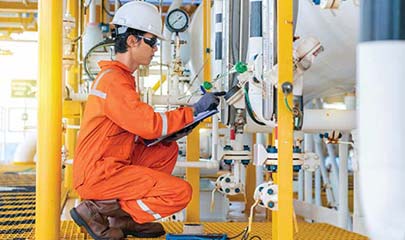Overview
The Certificate IV in Hazardous Areas – Electrical provides licensed electricians with a pathway to a nationally recognised qualification relevant to their work in explosive atmospheres. This qualification provides competencies related to the selection, installation, maintenance, inspection and testing of explosion-protected equipment and systems for control and monitoring of plant and processes.
The UEE42611 Certificate IV in Hazardous Areas – Electrical is made up of 23 core units and a range of elective units of competency. In order to attain this qualification, some of the units are credit transferred from a student’s electrical trade training and some are credit transferred from the Installation and Maintenance of Electrical Equipment in Hazardous Areas course. Competency Training offers the four remaining core units via Recognition of Prior Learning (RPL).
On enrolment, students are provided with a RPL kit. The kit contains questions and recommended documents for submission to provide the assessor with sufficient evidence to determine whether the student is competent in these units. Upon successful completion of the RPL assessment, a student will be awarded the qualification.
Course Outline:
This qualification provides competencies related to the selection, installation, maintenance, inspection and testing of explosion-protected equipment and systems for control and monitoring of plant and processes.
Recognition of Prior Learning:
This kit is provided on confirmation of enrolment, and provides guidance for the process of gathering evidence in support of the assessment application. The kit contains questions and recommended documents for submission to provide the assessor with sufficient evidence to determine whether the student is competent in these units.
Completion of the Qualification:
This qualification is made up of 23 core units and a range of elective units of competency. In order to complete the full Certificate IV in Hazardous Areas – Electrical qualification, you will need to:
- Provide CTE with a copy of your UEE30811 Certificate III in Electrotechnology or equivalent. 18 of the core units are credit transfers from your prior qualification.
- Successfully complete CTE’s 4-day EEHA Installation and Maintenance of Electrical Equipment in Hazardous Areas course (17 units, including 1 core unit).
- Successfully complete the Recognition of Prior Learning package to demonstrate competency in 4 core units.
- All components must be successfully completed before the qualification can be issued.
Duration
Self-paced Recognition of Prior Learning process (12 months)
Prerequisites
(UEE30811 Certificate III in Electrotechnology, or equivalent) An Electrical Licence and evidence of training in the EEHA Installation and Maintenance of Electrical Equipment in Hazardous Areas is required prior to enrolling in the Certificate IV in Hazardous Areas – Electrical.
Units of Competency:
- UEENEEE038B – Participate in development and follow a personal competency development plan
- UEENEEE117A – Implement and monitor OHS procedures and policies
- UEENEEE124A – Compile and produce an energy sector detailed report
- UEENEEK145A – Implement and monitor energy sector environmental and sustainable policies and Procedures
This list of units includes only those units that are completed by RPL with CTE. For further information on the qualification requirements, including packaging rules and core and elective units, please contact our training department or go to www.training.gov.au
Outcomes
Units of Competency
The following units are outcomes of the CTE’s EEHA Installation and Maintenance of Electrical Equipment In Hazardous Areas course:
- UEENEEM080A Report on the integrity of explosion-protected equipment in a hazardous area
- UEENEEM020A Attend to breakdowns in hazardous areas – gas atmospheres
- UEENEEM021A Attend to breakdowns in hazardous areas – dust atmospheres
- UEENEEM022A Attend to breakdowns in hazardous areas – pressurisation
- UEENEEM024A Install explosion-protected equipment and wiring systems – gas atmospheres
- UEENEEM025A Install explosion-protected equipment and wiring systems – dust atmospheres
- UEENEEM026A Install explosion-protected equipment and wiring systems – pressurisation
- UEENEEM028A Maintain equipment in hazardous areas – gas atmospheres
- UEENEEM029A Maintain equipment in hazardous areas – dust atmospheres
- UEENEEM030A Maintain equipment in hazardous areas – pressurisation
- UEENEEM039A Conduct testing of hazardous areas installations – gas atmospheres
- UEENEEM040A Conduct testing of hazardous areas installations – dust atmospheres
- UEENEEM041A Conduct testing of hazardous area installations – pressurisation
- UEENEEM042A Conduct visual inspection of hazardous areas installations
- UEENEEM044A Conduct detailed inspection of hazardous areas installations – gas atmospheres
- UEENEEM045A Conduct detailed inspection of hazardous areas installations – dust atmospheres
- UEENEEM046A Conduct detailed inspection of hazardous areas installations – pressurisation
Recognition of Prior Learning Units
The following Core units are assessed by Recognition of Prior Learning:
- UEENEEE038B Participate in development and follow a personal competency development plan
- UEENEEE117A Implement and monitor energy sector OHS policies and procedures
- UEENEEE124A Compile and produce an energy sector detailed report
- UEENEEK145A Implement and monitor energy sector environmental and sustainable policies and procedures
Credit Transfer Units
The following core units are credit transferred from the candidate’s prior qualification (e.g. UEE30811 Certificate III in Electrotechnology):
- UEENEEE101A Apply Occupational Health and Safety regulations, codes and practices in the workplace
- UEENEEE102A Fabricate, assemble and dismantle utilities industry components
- UEENEEE104A Solve problems in d.c. circuits
- UEENEEE105A Fix and secure electrotechnology equipment
- UEENEEE107A Use drawings, diagrams, schedules, standards, codes and specifications
- UEENEEE137A Document and apply measures to control OHS risks associated with electrotechnology work
- UEENEEG006A Solve problems in single and three phase low voltage machines
- UEENEEG033A Solve problems in single and three phase low voltage electrical apparatus and circuits
- UEENEEG063A Arrange circuits, control and protection for general electrical installations
- UEENEEG101A Solve problems in electromagnetic devices and related circuits
- UEENEEG102A Solve problems in low voltage a.c. circuits
- UEENEEG103A Install low voltage wiring and accessories
- UEENEEG104A Install appliances, switchgear and associated accessories for low voltage electrical installations
- UEENEEG105A Verify compliance and functionality of low voltage general electrical installations
- UEENEEG106A Terminate cables, cords and accessories for low voltage circuits
- UEENEEG107A Select wiring systems and cables for low voltage general electrical installations
- UEENEEG108A Trouble-shoot and repair faults in low voltage electrical apparatus and circuits
- UEENEEG109A Develop and connect electrical control circuits





